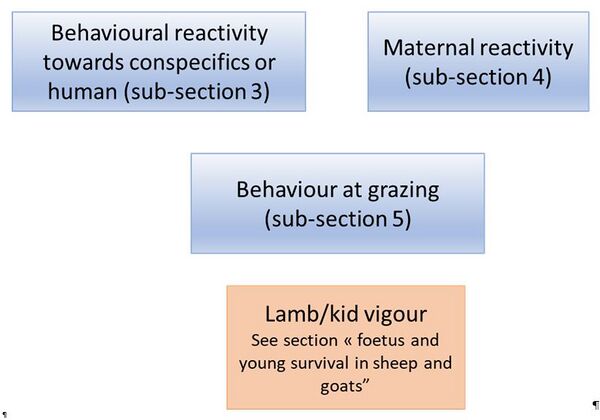Section 24: Recording resilience in sheep and goats
Guidelines on recording behavioural traits in sheep and goats
| Date of change | Nature of Change |
| October 2024 | First version |
| November 2024 | Tracked change revisions by JC |
| December 2024 | Tracked change revisions by MS |
Introduction and scope
Introduction
Genetic selection including behavioural traits could be an advantageous strategy for improving robustness and welfare of farm animals in various farming conditions by minimizing unsuitable responses to changes in their social and physical environment, limiting an excessive fear of humans and improving sociability (Mignon-Grasteau et al., 2005). Farm animals are social and gregarious, and relational behaviours are essential for ensuring social cohesion, social facilitation, offspring survival and docility toward humans. Breed differences and genetic variation within breed have been reported in lambs for early social behaviours and found to be heritable, and associated with some QTL, suggesting such behaviours could be selected early (Boissy et al., 2005; Beausoleil et al., 2012; Hazard et al., 2014; Cloete et al., 2020). In addition, such early social reactivity of lambs towards conspecifics or humans was identified as a robust trait and that selection for early social reactivity of lambs towards conspecifics or humans is feasible (Hazard et al., 2016; 2022).
The behaviour of both ewes and lambs, and their interaction at lambing, have been widely described. Such behaviour is important for the survival of the offspring, especially in extensive farming conditions as reviewed by Dwyer et al. (2014). Moreover, it has been shown that primiparous ewes are more prone to abandon their lambs due to their lack of maternal experience (Dwyer, 2008) and that lamb survival at birth is lowly heritable (Brien et al., 2014). Taken together these factors could hinder the development of extensive farming systems. Genetic selection on maternal attachment traits could therefore be advantageous to improve offspring survival and growth, and reduce labour, as suggested by Mignon-Grasteau et al. (2005). Genetic variations in maternal behaviour between breeds of sheep have been well documented (for review see: Dwyer, 2008; von Borstel et al., 2011) while little was known about within-breed genetic variability and even less about maternal reactivity traits. We hypothesized that maternal attachment to the litter has a genetic component in sheep, and we recently reported that as expected the maternal reactivity at lambing is a heritable trait (Hazard et al., 2020;2021).
Grazing behaviour is also important for animals raised in extensive production systems because it can support adaptability to changing environments. In particular, small ruminants reared in semi-extensive systems face many environmental and welfare challenges that are difficult to quantify. The evidence in the literature suggests that there are differences in grazing behaviour between and within breeds of sheep (Simm et al., 1996; Brand, 2000). The notion is that natural selection combined with subjective artificial selection have led to some animals being more adaptive to extensive conditions. In this regard, genetic variation may exist for key grazing behaviour traits (Simm et al., 1996; Dwyer et al., 2005), but relevant literature is scarce. During the SMARTER H2020 project, a study was performed on grazing behaviour of the indigenous Boutsko Greek mountainous sheep breed, which is reared semi-extensively. The results showed that duration of grazing and speed are heritable traits (Vouraki et al., 2025).
Acronyms used in these guidelines
AT Arena Test
CT Corridor Test
GPS Global Positioning System
LS Lambing Site
PCA Principal Component Analysis
Scope
The aim of the present report is i) to define the behavioural traits of interest, ii) to describe approaches for behavioural measurements, iii) to describe their use for genetic analysis and evaluation.
To-date, the present guidelines describe 3 groups of traits related to behaviour:
- Behavioural reactivity towards conspecifics or humans
- Maternal reactivity
- Behaviour at grazing
Kid/lamb vigour is a relevant behavioural trait, but this trait is tackled within the section “foetus and young survival in sheep and goats” of the guidelines.
Most of the work undertaken on behaviour concerned sheep. This has been particularly the case in SMARTER. Most of the recommendations might be applied to goats as well. Nevertheless, we will use the ovine terms in the guidelines below.

